From Art Journal 72, no. 1 (Spring 2013)

A thought expressed in the optative has been replaced by a representation in the present tense.
—Sigmund Freud
Subjunctive
Allow for a problem within contemporary art, a problem concerning emptiness. After experiencing and writing on installations that, say, immersed me in cave systems, faux-hospitals, or forests, after navigating landscapes of fur or video labyrinths, I found myself, often, elsewhere. A group of contemporary installations seemed overwhelmingly spare, a few small objects, and I began to wonder what such a shift of spatial tenancy meant. I’m thinking here of the work of artists like Ryan Gander, Jonathan Monk, Jason Dodge, Matt Keegan, and Gedi Sibony. In this essay, however, I want to focus on the exiguous groups of objects assembled by Trisha Donnelly. What do her works, as individual pieces that nevertheless produce a climate, allow?
To state the implicit: the way objects occupy space means, and objects establish meaning in and of themselves and through juxtaposition. Possibilities emerge or not. Often a discussion reserved for architecture, the spaces of art might also occlude or open themselves for inspection, and the objects therein can confront aggressively or demur attention. Thus, Donnelly’s provisionally filled exhibitions, when encountered, seem to occupy their galleries only tentatively. However, when objects do not congeal into a “whole” atmosphere, it might make their arrangement more visually pronounced, so much so that they might seem syntactic. Adding to this effect, which we might call a quasi-grammatical arrangement of objects, actual language circulates here as well; it makes this hesitant occupation of space richer. Indeed, language, speech, and text become primary forms within Donnelly’s oeuvre. Thus we might consider whether her objects, assembled as an installation, might not only demur attention, but make a proposal through their experiences consisting of images and text in space. To explain, I would tell a well-known tale again.
In 2002, in New York City, at the opening of her first major solo show, Donnelly entered the white confines of the Casey Kaplan gallery on horseback, dressed as a Napoleonic courier, and proceeded to deliver a speech of imperial abdication to the stunned crowd gathered there. Afterward, she left the spare gallery by the same means. Besides being sensational, and besides setting up the terms of her oeuvre, this speech act emphatically deployed the subjunctive case, the grammatical name for language that expresses a wish—or would have something a certain way. To quote from her proclamation: “If it need be termed surrender, then let it be so, for he has surrendered in word, not will. He has said, ‘My fall will be great but it will be useful.’ The emperor has fallen and he rests his weight upon your mind and mine and with this I am electric. I am electric.”1 So where is the subjunctive in this speech? The subjunctive case, in modern English, is not recognizable by an exclusive way it affects verbs (as in French or German, for instance), but, instead, by the “subjunctive mood,” which denotes a state that is wished for, possible, recommended, or hypothesized. In the excerpt above, Donnelly opens with a speculative and conditional salvo: “if it need be termed surrender.” Further, unlike the merely conditional, the consequence for such a proposition is speculative and, even, perpetual; “then let it be so, for he has surrendered in word, not will.” The sentence, “He has said, ‘My fall will be great but it will be useful,’” reads as a counterfactual quotation; the artist posits an effect, a proposed meaning, which may be plausible, but is also arguable. To wit, we should not take the quotation literally as the words of Napoleon, but as a sum-mation of the importance of his abdication. The next two sentences, although declarative, are also marked by this mood of speculation as Donnelly parses how and why this surrender might be helpful and, in her case, galvanizing.
The subjunctive is interesting not merely as a grammatical category, but in its relationship to the real (by which I mean, for now, the commonly held). Specifically, the irreality of the subjunctive, its hypothetical cast, would allow us to align verbal and visual representation more squarely with wish rather than, say, accuracy, reportage, or the agreed-upon qualities of an object or event. Indeed the irreal, unlike the unreal, would suggest events that might yet come into being or, even, that unrecognized possibilities might line the given. In this spirit, I offer the (subjunctive) subtext of Donnelly’s speech as it casts her, as an artist, as a messenger speaking of the end of empire: “Let the circumstance of art be one of defeat, that the artist may be defined in terms other than as a master of representation, victor, and the authoritative occupant of a given space. May an artist be defeated in some senses, vital in others, decidedly belated, post-war, post-victory. May she declare one kind of end, to be compelled, continuing, and productive in other, possible, ways.” Donnelly, through a subjunctive proposition, vitiates a certain kind of artistry in order to invigorate another kind of art practice, or another possibility for representation. She gives up victory in order to be flooded with power.
Beyond text, Donnelly diagrams a relationship between the image and the optative as well. Of course, to emphasize a diagrammatic relationship within contemporary art, or to consider this relationship to be art, is to summon relational aesthetics, a concept defined by Nicolas Bourriaud that has assumed a place of critical importance in the dialogue on contemporary installation and performance. However, the work analyzed here cannot be enfolded into his especially capacious theories. Bourriaud has offered that “This ‘chance’ [of relational aesthetics] can be summed up in just a few words: learning to inhabit the world in a better way. Otherwise put, the role of artworks is no longer to form imaginary and utopian realities, but to actually be ways of living and models of action within the existing real, whatever scale chosen by the artist.”2 A salutary observation about a certain strain of art from the 1990s, this claim would free artists from the exclusive production of objects and luxury items, and dislodge “work” from the confines of the gallery. At the same time, relational aesthetics would link art with the social, the political, the historical, and the practical; it would further erase the distinction between art and lived experience.3 Objects themselves would become only provisionally important.4 Nevertheless, this proposition fails to fully describe artwork discussed here. The pairing that will not hold is Bourriaud’s rejected “imaginary and utopian realities.” Donnelly, for instance, is offering up an imaginary reality, or an irreality, even if she speaks from a place of defeat that is decidedly not utopian. Moreover, the call for art “to actually be ways of living and models of action within the existing real” assumes that there is a reality beyond the imaginary and an actuality separate from the virtual. As will be apparent, the art discussed here does not assume the solidity of the actual or of the real.5 Finally, I assume that some art does nothing productive, need not strive for betterment, and may, through relation, produce intellectual consternation, even distress, under its environmental auspices.
Claire Bishop, among others, has done important work questioning the foundation of relational aesthetics, and Bourriaud’s writing has become ever more nuanced.6 Thus, the point of this essay is not to set up relational aesthetics as an antipode to the work I will discuss. Indeed, the networks of the political, the social, the historical, and the art-historical are often cast into relief in Donnelly’s installations. Yet we might say that these works speculate about action, or assume that the “existing real” holds within it reversibilities, multiplicities, and disasters.7
Finally, the epigraph that opens this essay seems especially helpful to the task at hand. Freud’s definition of a dream as a concretion of the optative manifesting itself in representation and, moreover, the implied idea that a representation may point toward a hypothesis, and a wish rather than a fact, allow for tenuousness to haunt the semiotic structure of all images, all art.8 Since I started by noticing something about the spaces of exhibition, I suggest that these wishes, benign or scary, dwell in the very arrangement of objects and in the fluid, open, signifying system that these objects set up.
Objects and Attachment
Instead of “whole spaces,” however, I want to start with a piece. Let ’em (2005) is a black-and-white photograph of a handwritten note, displaying the title, placed on an expanse of marble. To be more specific, when buying Let ’em, the owner receives an electronic file of the photograph, and “can print the image at any size, as much as he [or she] wishes.”9
Let ’em; if we were to follow the subjunctive instruction presented and represented in the piece, we would be flummoxed. Maddeningly nonspecific, the words seem to allow for everything. On the one hand, this suggests the social and cultural: “let ’em,” as a phrase, colloquially references a famous, albeit misattributed, quotation of Marie Antoinette (“Let them eat cake”), or perhaps a song of Paul McCartney (“Let ’Em In,” 1976), or even the controversial 1953 hanging of Derek Bentley, a mentally impaired British teenager convicted of murder for uttering the phrase “Let ’im have it, Chris!” during a robbery. But while the phrase connects to the social and the cultural, it also speaks to the artwork as artwork—reprinting the permission given to print the work. As a print, the artwork becomes a manifestation and artifact of Donnelly’s allowance, available for purchase.

This contemporary sculpture (is it a sculpture?) acts as a two-way passage—on the one hand, it heads inward to the ground of its own productive possibility, and on the other, outward, to the installation, if not the world.10 Everything attaches to it in evocative albeit not discursively transparent ways. All are let. While this piece’s phrase, its allowance, might indicate somewhere as large as everywhere, say, Donnelly also fiercely connects her objects to others in her spare installations. What one cannot ignore is that one of the “objects” in Donnelly’s installations, to which a phrase like this might attach, is a palpable vacancy.
Such paucity marked Donnelly’s 2008 installation at the Institute of Contem-porary Art in Philadelphia. Objects huddled on the back wall were small and provisional. Appearing as schematics or even as maquettes, the work might already be aligned with a proposition; the installation reads as an archive or as visual notes for an exhibition. This notional quality is furthered by the enigmatic representations within the videos, photos, and drawings. Here one encounters an exhibition as style board—a tool used for casual aesthetic reference in advertising, fashion, interior design, and movie pitches. Other than the seemingly heteroclite group of objects against the back wall, the rest of the gallery stood nearly abandoned, save for a pair of curtains hanging incongruently in the middle of the gallery, against a wall; they concealed a speaker that occasionally intoned, in a low and drawn-out drone, “Oh Egypt!” while, at other intervals, it played the sound of wind or the clanging of distant church bells.
What would this exhibition have us do? First, we might consider its form as guiding a certain type of traversal. Indeed the wide gulf of space between the entrance and the objects is, obviously, crucial; in the crossing, our intention, the catch of curiosity, the scanning for importance or cohesion, might form.
This space stirs investigation, and the mobile and investigative spectation that the installation allows parallels the work of the subjunctive: within the given one might draw a conclusion, observe an allowance, or deploy a hypothesis.
Then, if this installation taps our investigative ability, what conclusions might be drawn? At first glance, the pieces remain disjunctive, and, moreover, that sense of the pell-mell remains even as the objects might become more meaningfully related. And if the conclusion of the investigation remains foreclosed, it is not just because of the form of the installation—which stands without logical hierarchy and in sundry media—but because the images assembled suggest removal, desperate escapes, and subjects seen only at oblique angles.

Global Terms
A list of contents: drawings of ripcords, robes, shaded trajectories, decontexualized waterfalls, lozenges, and wide-brimmed hats (titled Danang). Also present: foam rubber gouged to look like topography, and droopy black latex balloons in shadowboxes (recalling Eva Hesse). These sit among photographs of shorelines (Canada), rocks massed like animals in the ocean, upside-down pipe organs (Vibration Station), draped fabric, twisting tubular forms, a film strip (showing, in its tiny frames, an Afghan dog running along a shore), black gloves on a black background, the word “Peralta” in the mouth of a wide bell, a masked person looking out through a bay window, and a partial, indeed headless, sphinx (titled Hand that holds the desert down). As for video, the word “Frances” hovered on the wall (and was titled California), and Donnelly herself, via video, mimicked various guitarists in ecstatic moments, slowed to haunting effect.
Let us start with this forensic mess. As a famous art historian tells us about the obviously lacking and inanimate signifier: “And where there’s a corpse, you could say, there’s a mystery.”11 Indeed, the installation could be seen as an extravagant semblance—a body or bodies—that illumines the distance between images and their vital, full-size referents. Given that, there is a way to quickly let the voracious theory of the postmodern consume the work here. I understand that the emphatic presence of the signifier as signifier in this display might lead us to see this material, these images, as meaningfully empty husks shucked from their referents. Yet what if we were to think of it as a proposal about its “content,” a proposal about place? Indeed, its empty spaces dramatize referential and literal distance. Beyond the mere form of the installation, its scale and heterogeneity, these images illumine a chasm between the mapped and unmapped.
Then: Danang, California, and Canada get named and abut images of samurai, deserts, and ripcords. Then: figures watch from stone buildings at oblique angles and waterfalls get lifted from context. Then: black gloves, an ode to Egpyt, wind through landscape, and church bells that ring from an indeterminate, orbiting distance. Donnelly does not wrench any set of signifiers from their referents, but alludes to and estranges vastly different places within the global, colonial, and biographical imagination.

Take something like Untitled II (Peralta), which appears, at first glance, to reference Stacy Peralta, the legendary Mexican-American skateboarder, film producer, and inventor of the brilliantly named move “frontside flip to fakey.” His name, sitting over a shiny bell or bowl, speaks indirectly of Venice, California, and its Z-Boys (the name of the group with which Peralta rode), but also calls to mind the late 1970s and early 1980s and the Golden State where Donnelly was born. Yet the signifier is more accommodating than that; it may attach to other locations, may as easily reference an avenue in San Francisco or Oakland. Moreover, it has, within the installation, a geographic cousin, the video called California, displaying the name “Frances” between two turning wheels. For this writer it recalled Frances Farmer, the actress whose career was cut short in 1943 by an unjust commitment to a mental institution—but while there was a connection to that biography, there was no definitive link. Indeed, names appear as evocative, disjointed, and beyond meaningful closure. So, then, a California of innovation and darkness, of identities filmed and forged, a place of image production and new forms of sport. Given that two personal names are conflated with place here (and a third name, Donnelly, hovers unnamed in the exhibition), instead of locating a place, California becomes a sobriquet grafted onto its beings, and where Venice, Italy, Mexico, and the Mexican-American get activated within its terrain.
Here we have a proposal about “taking place” in distanced, hybrid, and evocative ways. It would be jejune to merely note the gulf between cultural place and their signifiers. Rather, as the work of an artist who would announce herself within the paradox of defeat and power, perhaps we could also allow a current of possibility between these places and how we draw them, photograph them, brandish them. More than willful deployment of the gap between signifier and signified (or, indeed, the gap between the signifier and another signifier), an argument emerges about place, the place of imagination, and the image of the global.
Indeed, California is just one stake in the wide map that Donnelly suggests. Each of the signifiers she deploys here is, like those cartographic names standing in for whole regions, pathetic: traditional farmer hats standing in for Vietnam, the alignment of the desert with its tourist-plagued monuments, the culture of Afghanistan reduced to a small canine dot on a still filmstrip. These images of place, distanced, play in and against other images of the askew. Further, in the interstice of oblique occupation and possible escape (pull the ripcord), these objects might be seen not only as syntactical—because they stand for and signify singularly and relation to one another—but as subjunctive.
Here is how. Most obviously, this set of objects acts as a global and cultural footprint for Donnelly. For an artist born in the mid-1970s in California—in an age when Vietnam impacted her country, in an era that saw globalization, severe cultural crisis (Oh Egypt, indeed), wars in Afghanistan, the end of all sorts of empires, from the Soviet Union to American economic hegemony, in a life that saw culture spread across and be inflected by exploding media—this work might act like notes on where the artist has been, while also insisting that this conglomeration of places remains outside the single narrative of a life, or even with a single conceptual world. In her installation, places become interpolated or interpreted and delicate. The installation nearly utters, “Would this were a world.”12

This claim for place and places, however, would not claim the authority nor the rigor of borders. I am struck, in particular, with the fragility of presentation, the taped-up photos and provisional line-up; Donnelly suggests, in formal terms, that the assemblage here, the biographical and the colonial alliance of signifiers, can be taken down, or blown away, or reordered. It is the threat to the joined spaces and to the potential “vibration station” that can also arise when the signifiers stand together, that produces poignancy or, even, affect. As she said about her headless sphinx, which she refers to as Ramses: “I have this as a recurring image: if the back paw of Ramses were to lift, the desert would rise up into the atmosphere grain by grain.”13 Would that the desert were a grain-by-grain heap that could accumulate into a place. Would that a life and its landscape, inhabited and imagined, evoke without permanence. Would that a mass of pictures not assume the authority of a map, but suggest the contingency of spectatorship and being.
Or take the photograph of the shoreline (Canada): dense trees on the shore offer no visible ingress. Without this visual space to project into, sky, water, and trees band together in apparent ways. Also, because the piece is black and white, and not under glass, the different concentrations of chemical sediment that texture the photograph become a visibly striated barrier. Rather than a discoverable territory or a contact zone, the photograph brandishes an ornamented frieze of trees. Let us call this one model of vision: that investigatory regard would meet a nearly impermeable integument into which we cannot see.13 In this way we might feel a desire to see, recognize, and decode well up and crash against the photograph.

What seems clear is that place is experienced as alterity. I speak not merely of the places that are pictured, although certainly that is true, but of the place in which one is, the gallery. We might even understand place and image in ways that recall Homi K. Bhabba’s familiar conception of the colonial landscape. Applying Jacques Derrida’s notion of différence, Bhabba diagrams how the colonial sign, displaced onto another landscape, stands as different from, and divided from, the original. It is the distance from the original by which “colonial specularity, doubly inscribed, does not produce a mirror where the self apprehends itself; it is always the split screen of the self and its doubling, the hybrid.”14 While in Bhabba’s estimation the colonizer must disavow the fractured way in which the colonial sign works, Donnelly visibly demonstrates the already divided and displaced place of the signifier, and specifically the signifier of place. In this installation figures are masked, looking sideways and through windows. Information arrives as provisional, codes remain indecipherable, and no ambiance emerges.15
Seeing distance, then. Seeing, like the masked figure she photographs glancing out the window, askew. We should consider her little untitled photograph further. The unobtrusive way that Donnelly positions the work, slightly below the line of sight, works the viewer; one has to bend down and look into it, and, in that act, decipher the small image. Indeed, the image acts as a kind of a mirror. That distant figure faces toward us; it is hard to decipher whether or not he or she looks anywhere. Moreover, barriers, shiny and screened, erect themselves between us. I speak of the window, the obvious camera work that reduces any color to gray tones, the glossy surface and the exigencies of looking at a small figure that resists facial recognition. If, as a famous psychoanalyst has suggested, part of the work of gazing, or the work of the gaze, involves not only regard, but being regarded, and not only that, but screenings, literal and cultural, that allow and disallow recognition, then we might feel that situation clamp down when we regard this unknowable, even sinister, person.16 How is this figure not like us, as spectators, as we look into the foreign?

Indeed Donnelly produces markers of radicalization that emerge when seeing becomes difficult, anonymous, masked, interested, or secreted (think of terrorism, think of surveillance, think of hiding). This type of seeing is suggested within the little photograph, but also in the connection of installed objects. For example: If we see the drawing of the ripcord in relation to this photograph, how does the image of escape, obliteration, and safety wash against the photograph’s diagram of visual difficulty? How might either relate to the waterfall without a context, which looks like a tongue, and which we can imagine as an all-reflective surface of wild light, a sketch of a great glassy gesture in the middle of nowhere?
I want to be clear about the quality of this installation. The space Donnelly limns, diagrams, and creates is contingent, but not just generically so; she sets up a space that argues about location. Each thing we see throws looking, looking as, looking across the gulf of the global, into relief. The seemingly most banal of information—I am here and you are there— becomes a groundless relation.17 What replaces the sense of identifiable place is an entirely different terrain, evidenced best, perhaps, by a text piece that stands at the entrance of the gallery’s installation. Its proposition begins, “It is the recombination of the not so vast distance / (The vortex) / Now / If there is a climax to the object there is no object. With the assistance of this recording you will build a vortex. An endless point will emerge from the initial form and grow into a revolving point in the direction of the back of the room.”18
The text refers, on its face, to the gallery, the recording disguised in the curtain panels in the center, and the objects in the back of it. Donnelly would offer the manner to traverse the not-so-vast, but formidable, distance: as if compelled by a vortex. What does a vortex do to living beings? It forces them into its maw; its spiral throws stable objects into radical relation. And if the objects in this installation are never climactic points, but a centripetal collection of unfinished objects, then Donnelly makes a powerful argument for the global images here, as a chiasmus of places and people, as a diagram of looking, being looked at, and screened, and as extant in ensuing revolution, in turning.
Occupation
Let us say that the art here works by relation, and the global is an animate force in the work. What might the particular stance of the viewer do, meaning what might our spectation allow and disallow? What logic is produced or shored up?
I have implied a part answer: the commitment to notes and speculation, and to a viewing position that solicits and blocks our regard, makes the global, and specifically the postcolonial, imaginary incoherent. The global would inhere in our proposition of it, rather than as an entity we could represent. Rather than a mere picture of such a terrain, however, Donnelly makes it matter—producing suction, or a vortex, that we should call desire. To explain, I will end with a discussion of three pieces, and by circling back to the subjunctive quality of the oeuvre.19
Recently, Donnelly has worked with massive slabs of stone, deftly referencing classical art, architecture, geography, and geological history. An untitled sculpture of 2010 stands as typical: into a slab of black portoro limestone (often called granite), Donnelly incises, line by line, a shape that resembles both a chisel and a classical column. The thinness of the ridges and the fineness of the stepped relief stand in obvious contrast to the obdurate slab. This stone, approximately 200 million years old, from the Northern Italian province of La Spezia, was well sedimented during the Roman empire, and certainly during the Genoese and Italian governments that ruled in that place thereafter. Disinterred, it stands as mute witness to its history and region, which, after World War II, became known as “The Door to Zion,” the port for concentration camp survivors as they departed for what we now call Israel.

What might be done with the assurance, violence, and delicacy of the cuts to this seemingly infrangible, historical, and mute stone? Perhaps all too literally, this intervention demonstrates a conception of matter and force that would see inflection and fluidity in even the most eminent and monolithic of surfaces, a conception theorized by the philosopher Gilles Deleuze: “Thus it must be said that a body has a degree of hardness as well as a degree of fluidity, or that it is essentially elastic, the elastic force of bodies being the expression of the active compressive force exerted on matter. When a boat reaches a certain speed a wave becomes as hard as a wall of marble.”20 To wit—the indentations index a force that would open the surface, unsettle the sediments, and exploit the barely visible pores of the unfinished stone. Like Deleuze, however, I am less interested in the physics of compression and more in the theoretical implications when “matter is marbled, of two different styles.”21 The quotations come from Deleuze’s examination of the philosopher Gottfried Leibniz; in this book Deleuze is interested in matter, certainly, but also in a subject that exists only in predicates. Starkly contrasting Leibniz with René Descartes, Deleuze offers a permuting substance: “Essentialism makes a classic of Descartes, while Leibniz’s thought appears to be a profound Mannerism. Classicism needs a solid and constant attribute for substance, but Mannerism is fluid, and the spontaneity of manners replaces the essentiality of the attribute.”22

Let us return to Donnelly’s stone, and recall her image-slabs that connect into an installation. It is not that I want to argue only for a kind of art matter that might be visibly accessible or impermeable depending on the investigative force exerted. It is not that I want to argue only that inspection and desire, as animate forces, are bound up with Donnelly’s substances. Instead, in addition, I would have it that Donnelly’s work generates situations where relationality can be cast as disastrous, or where contingency counts as a threat.
Regard the cuts in the stone: act and force are both the quality of the piece and an unfolding system. The cuts substantiate the historical stone; they make it something. Beyond that we can imagine a coming-into-being that occurs as those preternaturally precise micro-canyons are examined: a force of reading, or regarding, also serves as the crux of the substance.23 Thus, if the quality of a piece lies less in attribute and more in the manner in which the matter is cast, these cuts evidence how force, electricity, energy, and the vortex, all of which are called on by Donnelly, deliver a subject (a column, a cut) at the expense of a different one. The manner of the stone annihilates an unchiseled stone, while mimicking the mining that took the stone from some other place and cast it as an object through an act of hollowing out.
Such relationality, mannerism, or performativity (depending on the discourse in which you speak) would constitute a subject undone at every point. Or, actually, it would suggest that certain locations, every location, might continue only in subjunctive forms, the act of proposing them, of conjuring them up, willing them. In this work, for instance, the negative spaces in the stone parallel the former stone—while suggesting, further, how similar matter was styled as temples or, recently, kitchen counters. Further, the stone itself is not the manifest substance it appears to be, but is mannered, and apprehended as such.
If we follow Donnelly’s line of thinking further, however, it is not just that that subjunctive speculation creates a substance, but it desubstantiates one as well. That is, for every stone, a blasted stone hovers; for every apprehensive urge to define a figure or a place, a fugitive escapes; for every present, a deep time. Pos-sibilities remain locked within the possible. Let us recall the abdication that opened this essay. While defeat, or its performance, may electrify its speaker, it nevertheless suggests infinite foreclosures. What I note, then, in Donnelly’s eccentric circling of a globe, a globe that unhouses and houses her as a subject, is sadness, dissolution, and defeat that stand in the very matter of the global. This loss, or damage, occurs even when thinking of a world—and, thus, within in the subjunctive case.
One might also think of Donnelly’s identical sculpted sphinxes (Untitled, 2008) that she places perpendicularly in separate rooms. They feature faces covered in pillows, and on top of the pillows, facing out, bright lamps whose beams become the sole source of illumination within their respective galleries. Like di-lated pupils, like lidless eyes, the sculptures mimic a sight line—a beam of light emanates from the culturally evocative objects at which we look. However, these twin sculptures propose more about the hidden than they do about the visible; they diagram a kind of visuality and evaluation in which mechanics is divorced from sentience.
I hope the line of my own inquiry is clear and considered. The subjunctive in Donnelly’s case registers, first, as embrace of the possible and a proposal about places and their exceedingly fragile and consternating relationship to their viewers. Rather than assuming that this contingent relationship, in which a world is suggested through a kind of evaluation or performance, is in itself without violence, or more generally without consequence, one finds it hard, within Donnelly’s oeuvre, to see any type of looking that does not call a substance into being at the cost of another possibility. So the constant becoming of performative evaluation and participation would entail, in its form, a constant disassembly and disavowal.
By way of conclusion: in the opening of her 2008 show, in the midst of questions and general discussion, Donnelly stopped to perform a small, unannounced act. She knelt on the floor, with a wooden box, and slid back its lid to reveal a tanto, a knife used most famously in the ritual suicide ceremony of Japanese samurai known as seppuku or hari-kari. After gazing at the knife for a moment or two, Donnelly slid the lid shut again. If we believe that speculation or proposals matter, then this one works to astonishing effect: because alongside the artist who continued is an artist whom we can imagine as terminated. Alongside the Donnelly that was in Philadelphia, was a Donnelly cast in the misapplied ritual of Japan. Within an opening, a danger and a closing. While any act of speculation might only line what “actually happened,” the plangency of Donnelly’s oeuvre lies in the suggestion of a substance that dwells within the criss-cross of seeing, being seen, and speculating within the compressive force of the world. And if Donnelly’s exhibitions appear empty, they would nevertheless conjure up, subjunctively, a great, palpable force. Imagine the energy released when we unbox knives, how the conversation after gets inflected, intense in a different way, shadowed. How might we consider, as irreal and real, the possibility that emerges within that imaginative zone? How might we think of that which disappears once speculation goes into full effect?
A term that comes most readily to mind resonates with one aspect of our present—occupy. This essay opened with the contention that the way objects occupy space signifies. During the course of this analysis, however, occupation seems to have less to do with physical presence, or rhetorical domination, and more to do with a kind of occupying activity that these few objects might solicit—an investigation they might commence, a mapping they might thwart—and a contingent ideation of the global they might unleash, all from the relative nothing of their installation.
Michael Jay McClure teaches the history and theory of contemporary art in the Departments of Art and Art History at the University of Wisconsin–Madison. He has written on the work of Matthew Barney, Felix Gonzalez-Torres, Pipilotti Rist, Jasper Johns, Pierre Huyghe, Roni Horn, and the dancer Jonah Bokaer, among others. He recently completed his first book-length manuscript, “Rematerialized: Queer Objects in Contemporary American Art.”
This essay originally appeared in the Spring 2013 issue of Art Journal.
- Trisha Donnelly, quoted on Donnelly page of Guggenheim Museum website, at www.guggenheim.org/new-york/collections/collection-online/artwork/10744, as of May 21, 2013. ↩
- Nicolas Bourriaud, Relational Aesthetics, trans. Simon Pleasance and Fronza Woods (Dijon: Les Presses du réel, 2002), 13. ↩
- This ambition for art, however, recalls the radical social program that existed within certain strains of 1960s Conceptual art. In other words, relational aesthetics is a summation and extension of Conceptual art’s program. For an excellent account of Conceptual art’s ambition, and a withering contemporary critique lodged by the artist Robert Smithson, see Blake Stimson, “The Promise of Conceptual Art,” in Conceptual Art: A Critical Anthology, ed. Alexander Alberro and Stimson (Cambridge, MA: MIT Press, 1999), xxxviii and 1. ↩
- See Lucy R. Lippard and John Chandler, “The Dematerialization of Art,” in Conceptual Art: A Critical Anthology, 46–50. ↩
- Pierre Nora, for instance, theorizes les lieux de mémoire, or places of memory, that can reference the discourse of history, or speak to the social, without assuming the solidity of the real. “One simple but decisive trait of lieux de mémoire sets them apart from every type of history to which we have become accustomed, ancient or modern. Every previous historical or scientific approach to memory, whether national or social, has concerned itself with realia, with things in themselves and in their immediate reality. Contrary to historical objects, however, lieux de mémoire have no referent in reality; or, rather, they are their own referent.” Nora, “Between Memory and History: Les Lieux de mémoire,” trans. Marc Roudebush, Representations 26 (Spring 1989): 23. ↩
- See Claire Bishop, “Antagonism and Relational Aesthetics,” October 110 (Fall 2004): 51–79. ↩
- See Bourriaud’s essay on the work of Pierre Huyghe, “The Reversability of the Real,” Tate, Etc. 7 (Summer 2006), at www.tate.org.uk/context-comment/articles/reversibility-real, as of May 21, 2013. ↩
- I suggest here a larger argument regarding the assumed earnestness of signification in structuralist linguistics and Freudian psychoanalysis. That is, even if we consider connotation and denotation, or manifest and latent content, there a way that such content is divided, defined, and granted veracity that still suggests a stability of meaning. Philosophers from Jacques Derrida to Luce Irigaray suggest a compressive fluidity that works in and against such structure, a type of fluidity, moreover, that cannot be isolated within the structure. ↩
- Website of Air de Paris, a gallery representing Donnelly, at www.airdeparis.com/donnelly/2005/let.htm, as of May 21, 2013. ↩
- See Rosalind Krauss, Passages in Modern Sculpture (Cambridge, MA: MIT Press, 1981). For Krauss, a sculpture not only refers or points to its inviolable shape as an object, but also points outward to or includes its surrounding space. Although concerned with Minimalist practice, the book anticipates, elegantly, installation art’s meaningful occupation of space, as well as Krauss’s career-spanning concern with medium. ↩
- Rosalind Krauss, The Optical Unconscious (Cambridge, MA: MIT Press, 1994), 251. ↩
- A parallel to my investigation might be Kaja Silverman, World Spectators (Stanford: Stanford University Press, 2000), especially in her formulation of contingent and intersubjective idea of space and time. However, while world for Silverman stands as the realm (and more precisely sphere) of appearances, I want to think specifically of the global as situated squarely within the signifying systems of cartography and other politics. ↩
- Donnelly, in Trisha Donnelly, exh. cat. (Philadelphia: Institute of Contemporary Art, 2008), n.p. The exhibition, organized by Jenelle Porter, took place April 5–August 3, 2008. ↩
- Homi K. Bhabba, “Signs Taken for Wonders: Questions of Ambivalence and Authority under a Tree outside Dehli, May 1817,” in The Location of Culture (New York and London: Routledge), 117. ↩
- Jill H. Casid demonstrates how the hybrid need not necessarily be resistant to colonialism. In her discussion of colonial gardens, she argues that the hybrid and the transplant were put in service of an imperial picturesque. For my purpose, I want to note, by contrast, how Donnelly purposefully avoids the circumambient, and thereby keeps the cultural fragmented and even incoherent. See Casid, “The Hybrid Production of Empire,” in Sowing Empire: Landscape and Colonization, (Minneapolis: University of Minnesota Press, 2005), 1–44. ↩
- Jacques Lacan, “Of the Gaze as Object Petit a,” in The Seminar of Jacques Lacan, vol. 11, The Four Fundamental Concepts of Psychoanalysis, trans. Alan Sheridan (New York: Norton, 1998), 67–121. ↩
- Jill H. Casid has helpfully suggested that we think of landscape as a verb, and also in peri-performative ways, describing in landscape “matter that becomes active, the latent possibility of a kind of ‘fixing’ that does not arrest but rather moves with the vertiginous and the whirling without converting such pivots into stasis.” Casid, “Epilogue: Landscape in, around, and under the Performative,” in Women and Performance: A Journal of Feminist Theory 21, no. 1 (March 2011): 98. ↩
- Donnelly, in Trisha Donnelly, n.p. ↩
- See Bishop, 78: “The tasks facing us today are to analyze how contemporary art addresses the viewer and to assess the quality of the audience relations it produces: the subject position that any work presupposes and the democratic notions it upholds, and how these are manifested in our experience of the work.” ↩
- Gilles Deleuze, The Fold: Leibniz and the Baroque, trans. Tom Conley (Minneapolis: University of Minnesota Press, 1993), 6. ↩
- Ibid., 4. ↩
- Ibid., 56. ↩
- I use the term “micro-canyons” to suggest a formal rhyme with Earth Art, especially the cuts in the landscape that Michael Heizer produced early in his career. Indeed, this stone looks like an expanded model of his Double Negative (1969). ↩

